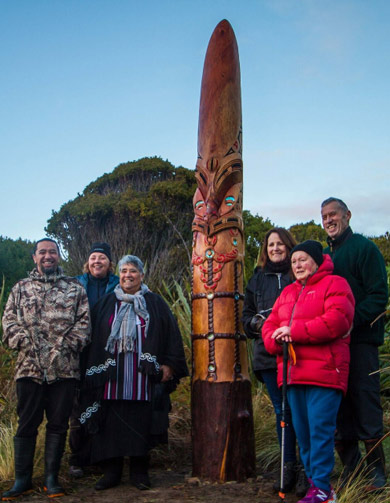Archived content: This media release was accurate on the date of publication.
Date: 14 September 2017

Left to right: Ngāi Tahu Carver James York, Ngāi Tahu Fund Chair Suzanne Ellison, Mahri Batey, Leanda Davis, Jane Davis, Tane Davis. Pictured with Te Pou Nehera
Ngāi Tahu and the Department of Conservation have been working together to erect the three pou to symbolise the importance of the island to Ngāi Tahu.
Whenua Hou Committee Chairman Tane Davis says the idea for installing the pou came about from discussions with the Whenua Hou Committee, which has representatives from the four papatipu rūnanga and conservation board, on how best to tell the story of the island's human history and preserve it for generations to come.
"We got talking about how to immortalise the stories of our past, preserve the present and look to the future. Whenua Hou was an important site for local iwi who used it as a stopping point on their journeys south to the Tītī Islands and it was the first location in the south where European men - mostly sealers - and Māori women lived together. Today the island is also an important site for conservation, being home to the largest population of kakapo. A sign wasn't going to cut it, we decided, and the idea of pou stemmed from there."
Department of Conservation Senior Ranger Biodiversity Ros Cole says the pou were the result of true partnership in action.
"From the early discussions right through to the unveiling, the common theme that really stuck out in everyone's minds was partnership – everyone working together to achieve something special. You could really feel the sense of pride and comradery from everyone involved to be working together on something so unique that celebrates our shared heritage," she says.
The journey from go to pou was a lengthy one; after deciding on a vision for the island, which as a nature reserve is only accessible to permit holders, the challenge was finding the appropriate materials for the pou. It was agreed that fallen tōtara from Whenua Hou would be used.
"We had DOC staff out scouring the forests of Whenua Hou for fallen tōtara logs that might fit the bill but the wairua of pou is unique – eventually Tane and carver James York offered to spend a few days on the island to see what they could find."
Tane says that trip proved incredibly valuable; not only did they find four rakau that were perfect they also noticed many of the trees had been ringbarked to make pōhā – a kelp bag used to store preserved muttonbird, which further reinforced the importance of this kaupapa
"This was a reminder of what our Ngāi Tahu tīpuna did in those early days. This connection to our heritage inspired the shape of the pou."
The three pou, named Te Pou Nehera, who represents the ancient people, Te Pou Haumi, whose two waka represent the journey of early Ngāi Tahu and European settlers and Te Pou Hou, who represents the present day, true partnership and the mystery of the future – took 18 months to carve and were unveiled at a dawn ceremony earlier this month. Many of those present at the unveiling had direct descendancy links to Whenua Hou.
Funding for the new pou came from the Ngāi Tahu Fund Committee with additional funding and support from DOC.
Whenua Hou's original pou, Hinekete who was installed by the Ashwell family in the early 1990s, had been laid to rest during an earlier internment.
Contact
Ros Cole
Department of Conservation
Phone: +64 3 211 2482
Tane Davis
Whenua Hou Committee
Mobile: +64 27 717 3656